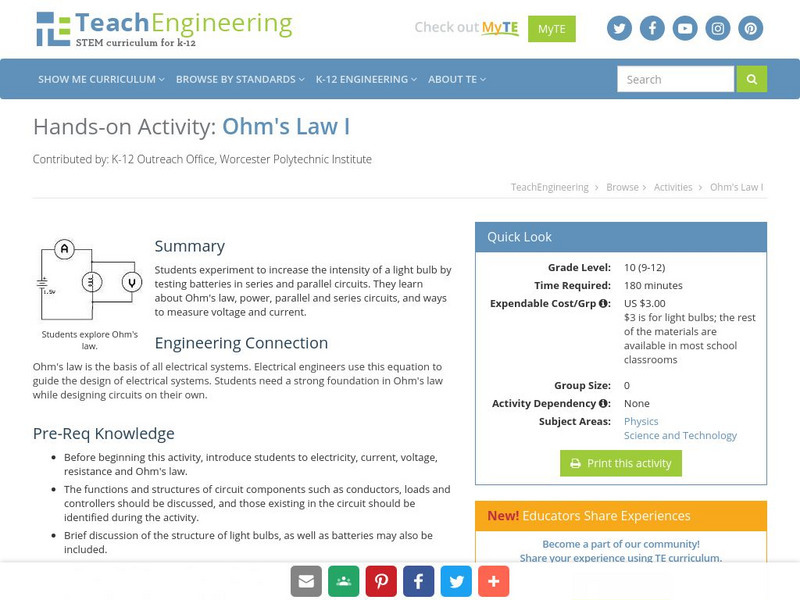TeachEngineering
Teach Engineering: Conductivity
Students make a simple conductivity tester using a battery and light bulb. They learn the difference between conductors and insulators of electrical energy as they test a variety of materials for their ability to conduct electricity.
TeachEngineering
Teach Engineering: Ohm's Law I
Students will work to increase the intensity of a light bulb by testing batteries in series and parallel circuits. It analyzes Ohm's Law, power, parallel and series circuits, and ways to measure voltage and current.
TeachEngineering
Teach Engineering: Potato Power
Students use potatoes to light an LED clock (or light bulb) as they learn how a battery works in a simple circuit and how chemical energy changes to electrical energy. As they learn more about electrical energy, they better understand...
PBS
Pbs Kids:activities and Videos: Electricity
This PBS site offers videos and activities are hands-on challenges that focus on the engineering design process. They use simple materials, allow for multiple solutions, and are ideal for ages 9-12.
University of Colorado
University of Colorado: Ph Et Interactive Simulations: Signal Circuit
Why do the lights turn on in a room as soon as you flip a switch? Flip the switch and watch the electrons. Does the light turn on immediately? Explain using observations of the model.
Science Buddies
Science Buddies: Solar Cell Power Output vs. Temperature
Solar cells provide a clean way of making electricity directly from sunlight. In this project you will build a simple circuit and experimental setup to investigate whether the power output of a solar cell changes with ambient temperature.
TeachEngineering
Teach Engineering: Simple Coulter Counter
Students build and use a very basic Coulter electric sensing zone particle counter to count an unknown number of particles in a sample of "paint" to determine if enough particles per ml of paint exist to meet a quality standard. In a lab...
TeachEngineering
Teach Engineering: Pointing at Maximum Power for Pv
Student teams measure voltage and current in order to determine the power output of a photovoltaic (PV) panel. They vary the resistance in a simple circuit connected to the panel to demonstrate the effects on voltage, current, and power...
Science Struck
Science Struck: Amperage vs. Voltage What Is the Difference?
This article explains what voltage and amperage are and the effect batteries have on them in an electrical circuit.
Interactive Mathematics
Interactive Mathematics: Differential Equations
This tutorial shows how differential equations apply to electrical circuits. Includes other real world applications, examples, and formulas.
PBS
Pbs Kids: Design Squad Challenge: Dance Pad Mania (Pdf) [Pdf]
Hands-on challenge to build a dance pad that lets you use your feet to either flash a light or to sound a buzzer. Provides full list of materials with ideas on how to design, build, test, and redesign the pad if necessary. Activity...
Khan Academy
Khan Academy: Application of the Fundamental Laws
We solve a circuit by direct application of the fundamental laws: Apply element laws (Ohm's Law and the like) plus Kirchhoff's Laws to solve for the currents and voltages of a circuit.
Georgia State University
Georgia State University: Hyper Physics: Ohm's Law and Current Law
At this site from Georgia State University Ohm's law is stated in words and using equations. A JavaScript form allows for multiple practice problems with instant feedback and reinforcement. Kirchoff's current law is stated and...
Khan Academy
Khan Academy: Dc Ammeters and Voltmeters Review
Review the key terms and skills related to voltmeters and ammeters, including where to place them in a circuit.
Physics Classroom
The Physics Classroom: Power: Putting Charges to Work
In this tutorial the concept of how electrical energy is transformed is introduced. Learn how electric charges actually work and take the interactive quiz to assess your understanding.
Physics Classroom
The Physics Classroom: Power Revisited
This tutorial visits the concept of power. You will learn to develop new equations that express power in terms of current, electric potential difference and resistance.
Other popular searches
- Simple Electrical Circuits
- Draw Electrical Circuits
- Electrical Circuits and Math
- Electrical Circuits Physics
- Science Electrical Circuits
- Building Electrical Circuits
- Electrical Circuits Review
- Electrical Circuits Hands
- Electrical Circuits Activity
- Hidden Electrical Circuits
- Electrical Circuits Vocabulary










![Pbs Kids: Design Squad Challenge: Dance Pad Mania (Pdf) [Pdf] Handout Pbs Kids: Design Squad Challenge: Dance Pad Mania (Pdf) [Pdf] Handout](https://content.lessonplanet.com/knovation/original/39874-4adfadd8b52b66e71cac53cd55883d55.jpg?1661243850)


